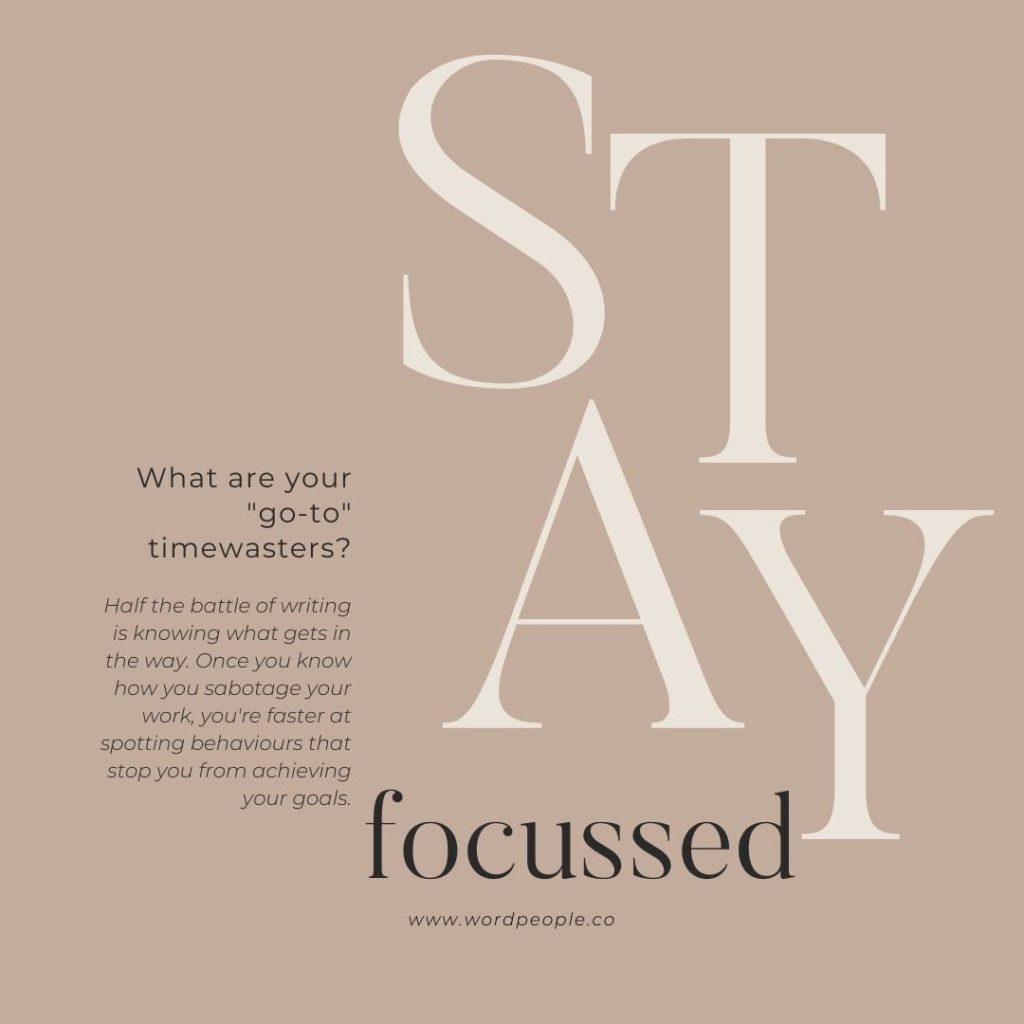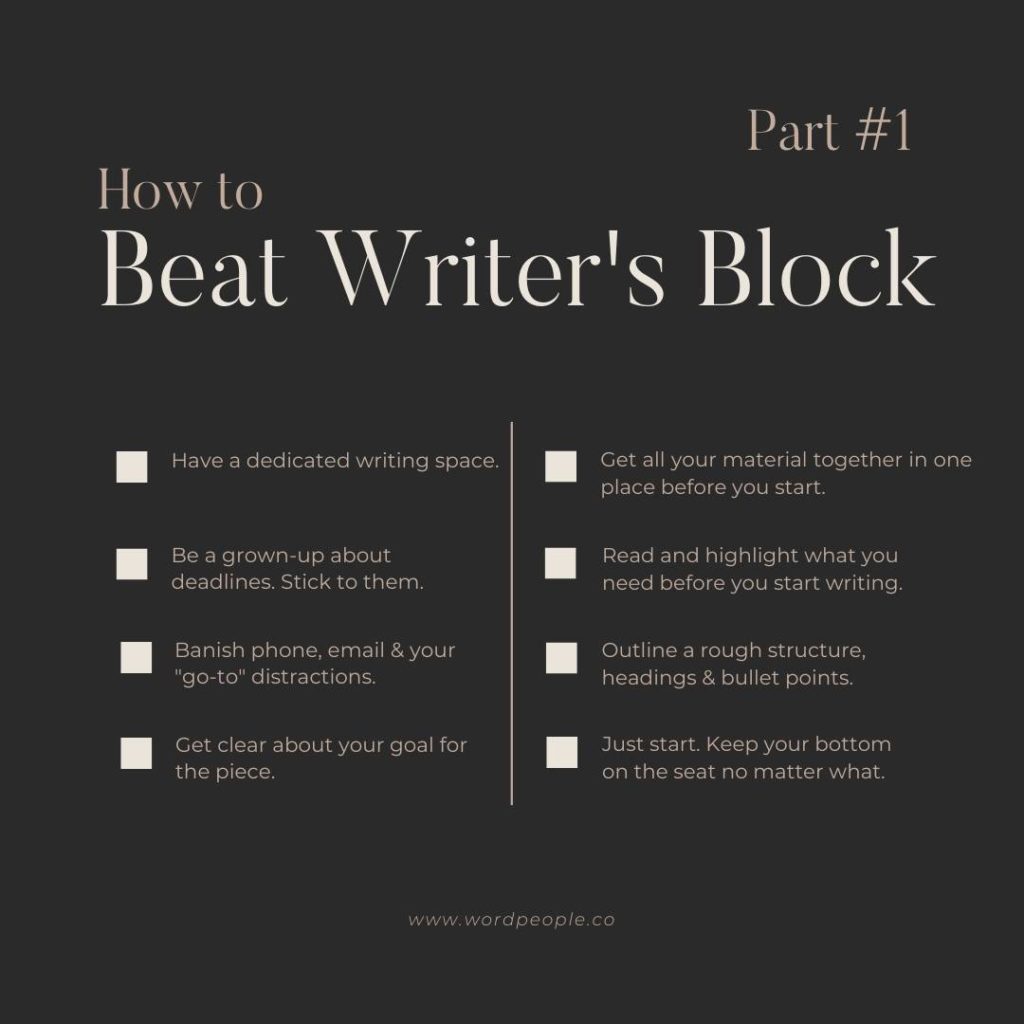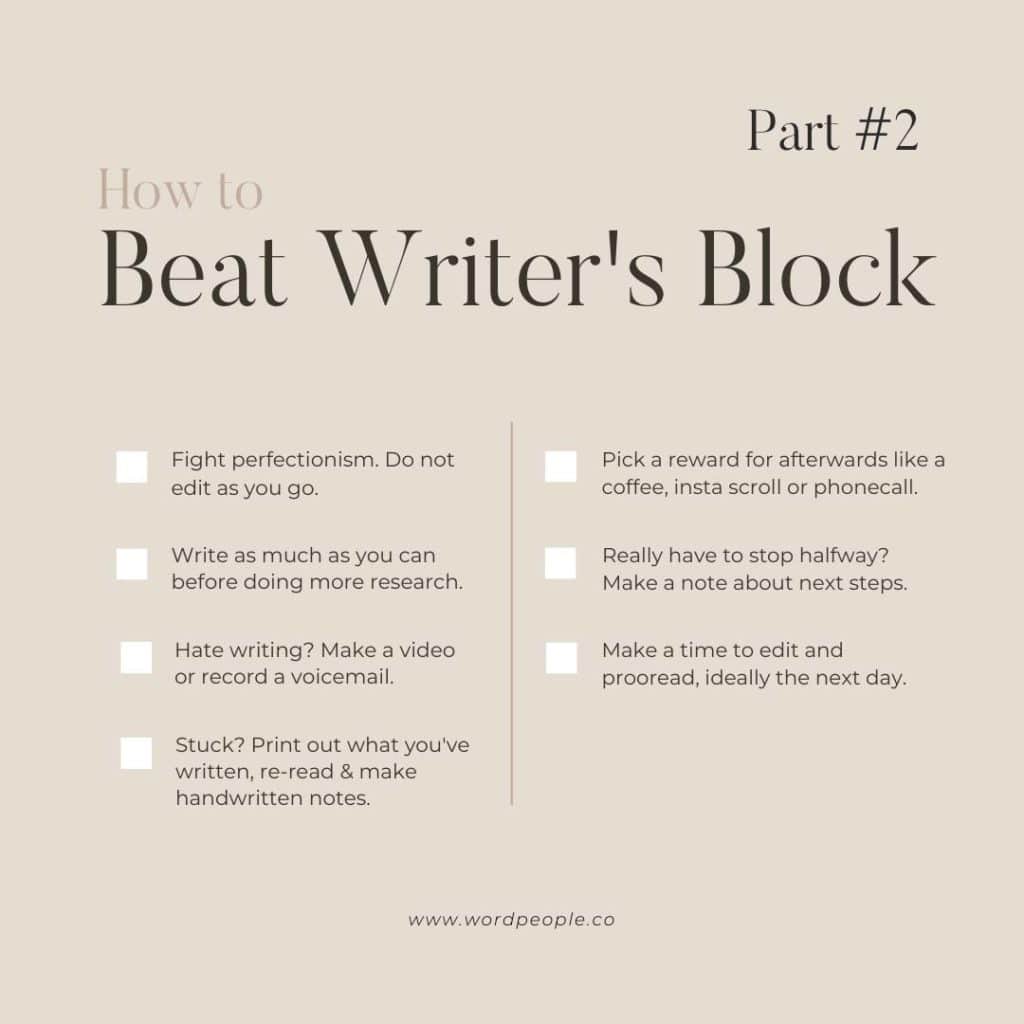One of the biggest issues that my writing students struggle with is writer’s block. Here are some tips and tricks to help you speed up your writing and reduce the chance of it happening next time.
What is writer’s block?
Writer’s block is anything that stops you from writing. You know you have it when you feel completely stuck about what to write next.
What are some examples?
Writer’s block manifests in different forms so it is actually really useful to recognize how it appears for you. Even after being a professional writer and freelance journalist since 2006, I know when I’m stuck when I am literally up and down from my chair like a Yo-Yo. For me it looks like making cups of tea, getting water, answering the door for the DHL man or checking my calendar “just in case” I have any appointments in the next 10 minutes.

The bad news is that writer’s block never ever goes away completely.
The secret is knowing when you’re stuck and doing enough pre-writing work or preparation before you start your project.
What causes it?
Writer’s block is typically caused by a lack of preparation, lack of self-discipline, perfectionism or even a simple lack of interest in the topic.
People often get stuck because they’re simply not clear about why they’re writing. J.J. Peterson from StoryBrand marketing messaging recommends always having a “controlling idea”. This means what is the main message or theme that you want the reader to walk away with after they finish.
How to beat writer’s block
In order to be as efficient as possible in the writing process, it is critical to be prepared before you sit down.

Here is a quick list of tips:
1. Go to your dedicated writing space
This is either your normal work desk or in a cafe but somewhere the brain knows that this is focused work time. I do all my research on a large Mac desktop where I can have 30 tabs open and then take my laptop out to a cafe where I have to just write.
2. Be a grown-up about deadlines and stick to them
Break the writing process down in your calendar and stick to it. For example, one hour of research will be done by x date, 2 hours of writing by then and 30 minutes of editing and proofing by then.
3. Cut your distractions
Set your phone to silent and with a timer e.g. 50 minutes. It’s a basic suggestion but one that is actually useful to keep you focused and distraction-free. Close your email program, so you’re not tempted to even check anything “in case” it is urgent.
4. Get clear
What is the goal of the piece? What do you want the reader to think, feel and do after reading it?
5. Be organized
Get all your material gathered in one place. This includes research that you’ve previously done and samples of writing or articles that are relevant. It’s also inspiring to have a similar target piece nearby so you can see what it is you have to achieve by the end. If you are not ready to write yet, use the time as dedicated research time with a clear goal.
6. Do some reading
Read over all the notes and research that you’ve collected, highlighting important points.
7. Sketch it out
Outline a rough structure, potential headings, and bullet points. You can reorder everything later.

8. Just start
Keep your bottom on the seat no matter what. Remember your first draft is just an initial brain dump. It is in the editing that you’ll start to see the article take shape.
9. Put down the red pen
To deal with perfectionism, do not edit as you go. This is a form of procrastination dressed up as “working”. It is best to edit your piece after it has a chance to rest and you have taken a break, ideally until the next day.
Try and write as much as you can without leaving the document. I know that as soon as I have to do more research online, it can turn into 1 hour instead of a simple 10-minute exercise.
10. Try a different method
If you really hate writing, try making a video. You can also record a long voice memo on your phone and use software like Otter.ai to transcribe it.
11. Make some notes
If you are still really stuck, print out what you’ve written so far and start making handwritten notes about what else you could add, particularly in terms of visual diagrams.
12. Pick a reward
Give yourself something nice to do afterwards like a coffee, an insta scroll or a walk.
13. Put a pin in it
If you still haven’t finished yet, it is good practice to make a note at the end of the article about the next steps. This will help you to quickly get back on track the next time that you come back to it.
Examples include:
-
Find or create images to accompany blog post
-
Get XZY to approve quotes.
-
Make another appointment in the calendar to edit, ideally the next day.
Summary
The process of writing doesn’t have to be hard. It’s about preparation, persistence and knowing what get’s in your way.
You might also be interested in:
-
My free guide: “How to Write for the Web”.
-
Sample Guest Blog: Attract More Clients Online: Serve First, Sell Second
-
Take the Quiz: What type of content marketer are you?
If you’re ready to jumpstart your website’s blog with regular high-quality content, see my SEO-optimized blog packages or set up a quick consultation.

Melissa Birchler
Melissa Birchler is a content specialist and experienced freelance journalist. She helps create successful content marketing programs for firms in the services sector.

